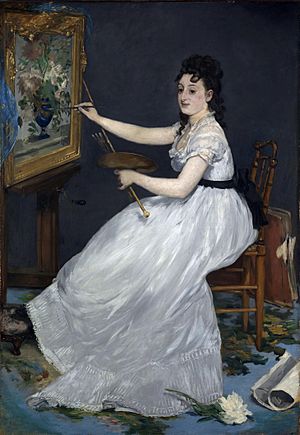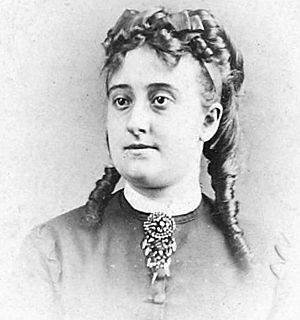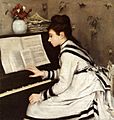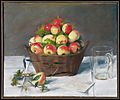Eva Gonzalès facts for kids

Eva Gonzalès (born April 19, 1849 – died May 6, 1883) was a talented French Impressionist painter. She was one of the four most famous female Impressionists in the 1800s. The others were Mary Cassatt, Berthe Morisot, and Marie Bracquemond.
Contents
Early Life and Art Training
Eva Gonzalès was born in Paris, France. Her father, Emmanuel Gonzalès, was a writer. He helped her meet many important people in the art and writing world from a young age.
In 1865, when Eva was 16, she started her art training. She took drawing lessons from a famous portrait painter named Charles Chaplin. Through her father's connections, she learned about new ideas in art and literature. Three years later, she met the famous painter Édouard Manet. Soon, she became his model and then his student.
Learning from Édouard Manet
Eva Gonzalès is best known for being a student of Édouard Manet. She started learning from him in February 1869. Manet had received some bad reviews for his art. This made him not want to talk about his work much. But Eva's presence seemed to help him open up.
Manet started painting a portrait of her right away. He finished it in March 1870. This painting, called Mlle E.G., was shown at the Paris Salon that year. Sadly, her own first paintings shown at the Salon were not noticed as much. Manet's portrait of her got more attention.
In the Portrait of Eva Gonzalès, Manet showed her working at an easel. But her stiff pose and fancy dress made it look like she wasn't ready to paint. Some critics thought she was just a young model working with an older, famous male painter. Eva Gonzalès was Manet's only official student. She also modeled for other Impressionist artists.
Eva's painting style was very similar to Manet's early work. Over time, she made small changes. She used a serious color palette and focused on everyday life. Manet's guidance strongly influenced her art.
Around 1871, Manet started using brighter colors. He also made his paintings look more active, like other Impressionists. Eva, however, kept using neutral colors and clear outlines from the 1860s. She used pastels in softer tones, which made her paintings look lighter.
Eva's work might not be seen as completely new. But it has a special charm and shows her true feelings. This makes her art very valuable. Even though she was Manet's student, her work had its own meaning. It developed in a way that suited her personality perfectly.
Art Career and Later Life
Art critics at the Salon praised Eva Gonzalès's work. They liked her natural artistic talent and her technical skills. At one point, she listed Charles Chaplin as her teacher when submitting art to the Salon. She might have done this to be taken more seriously.
However, her large painting, Box at the Théâtre des Italiens (1874), was rejected by the Salon jury. They said it had "masculine vigor." This made them question if she had truly painted it herself. Still, many critics reviewed her work positively. Famous writers like Louis Leroy, Jules Castagnary, and Émile Zola praised the art she successfully showed at the Salons. Also, art critic Maria Deraismes supported Gonzalès. She said Eva's paintings challenged how female painters were seen in Paris.
Like Édouard Manet, Eva Gonzalès never showed her art in the Impressionist exhibitions in Paris. But she is still considered part of the group because of her painting style. While studying with Manet, her self-portraits show she was exploring her own identity as an artist. She subtly corrected how Manet saw her. Until 1872, Manet strongly influenced her. But later, she developed her own unique style.
You can see this in paintings like Enfant de Troupe (1870). This painting is similar to Manet's Le Fifre (1866). Many of her later paintings showed her sister, Jeanne. Eva often used her family members, especially her husband and her sister Jeanne Gonzalès, as models in her art.
In 1879, after being engaged for three years, she married Henri Guérard. He was a graphic artist and Manet's engraver. The couple had a son named Jean Raimond in April 1883. This was shortly before they heard that Manet had died. During the Franco-Prussian War, Eva found safety in Dieppe.
Her work was shown at the art review L'Art in 1882. It was also shown at the Galerie Georges Petit in 1883. Today, one of Eva Gonzalès's most famous works is A Loge in the Théàtre des Italiens (1874). It is described as "one of the most thought-provoking paintings of its day."
Death
In 1883, Eva Gonzalès died at age 34 while giving birth. This happened five days after her teacher, Édouard Manet, passed away. Her son was then raised by his father and her sister, Jeanne. Jeanne later became Guérard's second wife.
Since her death, Eva Gonzalès's work has been shown in many exhibitions. These include the Salons de La Vie Moderne (1885) and the Salon d'Automne (1907). Her art was also shown at several galleries in Paris. In 1952, her work was exhibited at the Musée National des Beaux-Arts in Monte Carlo.
Accomplishments
The French government and private collectors have bought Eva Gonzalès's paintings. Her son and his family own the largest collection of her works.
Other achievements in her career include the newspaper L'Art buying her pastel paintings. She also received recognition in England, Belgium, and France.
In the mid-1870s, Eva started trying out pastels. This allowed her pastel works to be seen as complete paintings. These might be her most successful works. She is an important figure in the Impressionist movement.
Before she died at age 34, Eva Gonzalès showed her work in many important group exhibitions.
Gallery
Selected Exhibitions
| Selected Eva Gonzalès Solo Exhibitions | Date |
| Paris, Salons de la Vie moderne. Catalogue des peintres et pastels de Eva Gonzalès. | 1885, January |
| Paris, Galerie Berhneim-Jeune. Eva Gonzalès. | 1914, March–April |
| Paris, Galerie Marcel Bernheim. Eva Gonzalès, retrospective. | 1932. June 20 – July 9 |
| Paris, Alfred Daber. Eva Gonzalès. | 1950. March 10 – April 1 |
| Principauté de Monaco. Sporting. Eva Gonzalès. | 1952, March 3–23 |
| Paris. Galerie Daber. Eva Gonzalès retrospective. | 1959, May 28 – June 3 |
| She also had many group exhibitions, often with Berthe Morisot and Mary Cassatt. |
See also
 In Spanish: Eva Gonzalès para niños
In Spanish: Eva Gonzalès para niños























